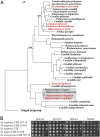Massive programmed translational jumping in mitochondria
- PMID: 24711422
- PMCID: PMC4000857
- DOI: 10.1073/pnas.1322190111
Massive programmed translational jumping in mitochondria
Abstract
Programmed translational bypassing is a process whereby ribosomes "ignore" a substantial interval of mRNA sequence. Although discovered 25 y ago, the only experimentally confirmed example of this puzzling phenomenon is expression of the bacteriophage T4 gene 60. Bypassing requires translational blockage at a "takeoff codon" immediately upstream of a stop codon followed by a hairpin, which causes peptidyl-tRNA dissociation and reassociation with a matching "landing triplet" 50 nt downstream, where translation resumes. Here, we report 81 translational bypassing elements (byps) in mitochondria of the yeast Magnusiomyces capitatus and demonstrate in three cases, by transcript analysis and proteomics, that byps are retained in mitochondrial mRNAs but not translated. Although mitochondrial byps resemble the bypass sequence in the T4 gene 60, they utilize unused codons instead of stops for translational blockage and have relaxed matching rules for takeoff/landing sites. We detected byp-like sequences also in mtDNAs of several Saccharomycetales, indicating that byps are mobile genetic elements. These byp-like sequences lack bypassing activity and are tolerated when inserted in-frame in variable protein regions. We hypothesize that byp-like elements have the potential to contribute to evolutionary diversification of proteins by adding new domains that allow exploration of new structures and functions.
Keywords: heterologous expression; mitochondrial genome; proteome analysis; ribosome hopping.
Conflict of interest statement
The authors declare no conflict of interest.
Figures



References
-
- Wills NM (2010) Translational bypassing: Peptidyl-tRNA repairing at non-overlapping sites. Recoding: Expansion of Decoding Rules Enriches Gene Expression, Nucleic Acids and Molecular Biology, eds Atkins JF, Gesteland RF (Springer, New York), Vol 24, pp 365–380.
-
- Herr AJ, Atkins JF, Gesteland RF. Coupling of open reading frames by translational bypassing. Annu Rev Biochem. 2000;69:343–372. - PubMed
-
- Huang WM, et al. A persistent untranslated sequence within bacteriophage T4 DNA topoisomerase gene 60. Science. 1988;239(4843):1005–1012. - PubMed
-
- Manch-Citron JN, Dey A, Schneider R, Nguyen NY. The translational hop junction and the 5′ transcriptional start site for the Prevotella loescheii adhesin encoded by plaA. Curr Microbiol. 1999;38(1):22–26. - PubMed
Publication types
MeSH terms
Substances
Associated data
- Actions
- Actions
- Actions
- Actions
- Actions
Grants and funding
LinkOut - more resources
Full Text Sources
Other Literature Sources
Molecular Biology Databases
Research Materials

